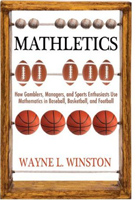In the top of the 1st inning of the June 28, 2009 Mets Yankee game Derek Jeter led off the first inning with a double. Then Nick Swisher hit a ground ball to Mets first basemen Dan Murphy. Surprisingly, Murphy eschewed the safe play of retiring the batter at first and threw to 3rd base in an attempt to nail Jeter, who was trying to advance to 3rd. The ESPN announcers criticized Murphy for allowing the possibility of a big inning. Murphy threw late to 3rd so Jeter was safe at 3rd and Swisher was of course safe at first. The Yankees went on to score three runs in the first inning and won the game 4-2. In hindsight, it is clear that Murphy’s gamble backfired, but when the ball was hit to him how should he have decided whether or not to throw to 3rd base?
If Murphy throws to third then in all likelihood one of the following will occur.
- Jeter is out and Yankees have a runner on 1st with one out. In this situation MLB teams average scoring .55 runs.
- Jeter is safe and the Yankees have runners on 1st and 3rd with none out. In this situation MLB teams average scoring 1.86 runs.
If Murphy takes the safe play and retires Swisher at 1st base, then Jeter moves to 3rd base and the Yankees have a runner on 3rd base with one out. In this situation MLB teams average scoring .98 runs.
Let P = probability that Murphy gets Jeter out at 3rd base. If
P(.55)+ (1-P)1.86> .98
then the Mets are better off (on average)with Swisher throwing to 3rd. A little algebra shows that Murphy needed around a .67 (or 2/3) chance of nailing Jeter to make throwing to 3rd the right play. While watching the game my gut feeling was that Murphy had around a 50-50 chance of nailing Jeter, so if I were in Murphy’s shoes I would not have thrown to 3rd. The point is that if the Mets had worked through this analysis Murphy would have been able to translate his personal view of the probability of a successful play into making the proper decision. Chapter 6 of my book Mathletics has many examples of how basic probability theory can be used to help baseball teams make better in game decisions.

 My book Mathletics
My book Mathletics